Capric Acid Market Size 2025-2029
The capric acid market size is forecast to increase by USD 149.9 million, at a CAGR of 7.6% between 2024 and 2029.
- The market is driven by the increasing consumer trend towards natural and organic personal care products. This preference for natural ingredients fuels the demand for Capric Acid, a naturally occurring fatty acid, in various applications. Another key driver is the technological advancements in production methods, enabling increased efficiency and cost savings for manufacturers. However, the market faces challenges due to the volatility in prices of raw materials such as coconut oil and palm kernel oil, which are primary sources of Capric Acid.
- Companies must navigate these price fluctuations and explore alternative sourcing options to maintain profitability and competitiveness. To capitalize on market opportunities, businesses should focus on innovation and differentiation, leveraging the natural and organic positioning of Capric Acid in personal care products. Additionally, exploring alternative raw material sources and optimizing production processes can help mitigate the impact of price fluctuations and ensure long-term success in the market. Capric Acid Esters are gaining popularity in the nutraceuticals industry, particularly in skincare and haircare products, as clean label ingredients.
What will be the Size of the Capric Acid Market during the forecast period?
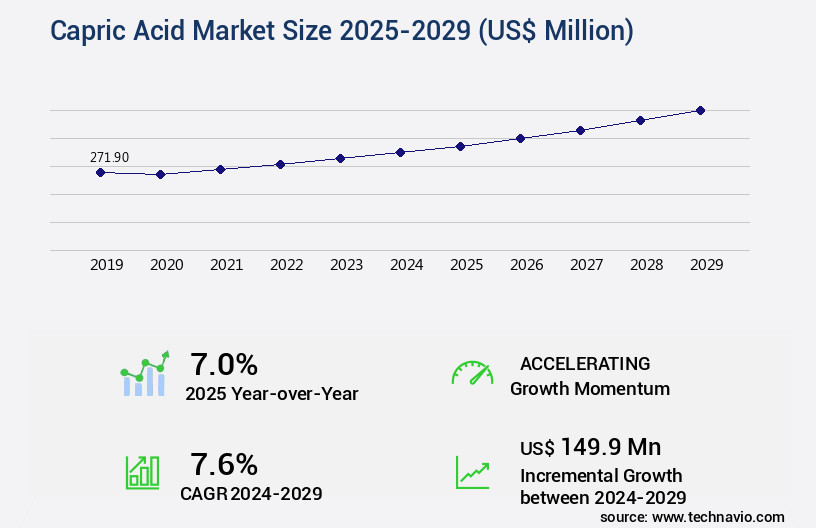
Get Key Insights on Market Forecast (PDF) Request Free Sample
- The market exhibits a dynamic and evolving nature, driven by the expanding applications across various sectors. In skincare formulations, the purity standards for capric acid are stringent, ensuring the hydrolysis process maintains the surfactant properties essential for effective cleansing. The hydrolysis process, a critical step in capric acid production, undergoes rigorous quality control methods, including gas chromatography analysis and sensory evaluation. Coconut oil extraction is another significant process in the market, with the fungicidal activity of capric acid playing a crucial role in maintaining the oil's shelf life. Capric acid's antimicrobial properties contribute to its use in food preservation methods, while its solubility in water and oxidation stability make it a desirable ingredient in biodiesel production.
- The industry's growth expectations remain robust, with a projected increase of 5% annually. Caprylic acid content in medium-chain triglycerides is a key focus area, with ongoing research into esterification reactions and melting point determination to optimize production processes. An example of capric acid's versatility can be seen in its use as an emulsifier in detergent manufacturing, where it enhances the product's performance and stability under various storage conditions. Infrared spectroscopy and acid value measurement are essential tools for assessing the chemical composition and quality of capric acid. Capric acid's antifungal applications extend beyond skincare, with significant potential in the pharmaceutical industry.
- Thermal stability testing and nuclear magnetic resonance analysis are crucial in understanding its antifungal properties and toxicity assessment. Packaging requirements and shelf life testing are essential considerations for capric acid producers, ensuring the product's stability and maintaining its value in the market. The ongoing research and development efforts in the capric acid industry continue to unveil new applications and production methods, further solidifying its role as a valuable ingredient in various sectors.
How is this Capric Acid Industry segmented?
The capric acid industry research report provides comprehensive data (region-wise segment analysis), with forecasts and estimates in "USD million" for the period 2025-2029, as well as historical data from 2019-2023 for the following segments.
- Application
- Food and beverages
- Personal care
- Pharmaceuticals
- Others
- Source
- Grade Type
- Food grade
- Industrial grade
- Cosmetic grade
- Geography
- North America
- Europe
- APAC
- Australia
- China
- India
- Japan
- South Korea
- Rest of World (ROW)
By Application Insights
The Food and beverages segment is estimated to witness significant growth during the forecast period. Capric acid, a medium-chain fatty acid, plays a significant role in various industries due to its unique properties. In skincare formulations, capric acid functions as a surfactant and exhibits antimicrobial and antifungal activities. Its production involves hydrolysis, a process that breaks down triglycerides into glycerol and capric acid. Gas chromatography analysis and infrared spectroscopy are essential techniques for evaluating capric acid's purity and chemical composition. Caprylic acid content, saponification value, and solubility in water are critical factors influencing its performance in different applications. The hydrolysis process also contributes to the production of capric acid from coconut oil and palm kernel oil.
The market is expected to grow by 15% in the coming years due to increasing consumer awareness of health and wellness, leading to a higher demand for natural food additives. Additionally, the cosmetic industry is anticipated to experience a growth of around 12% in the same period, driven by the rising trend of using natural ingredients in personal care products. Capric acid's versatility and functional benefits make it a valuable ingredient in various sectors, ensuring its continued relevance in the market.
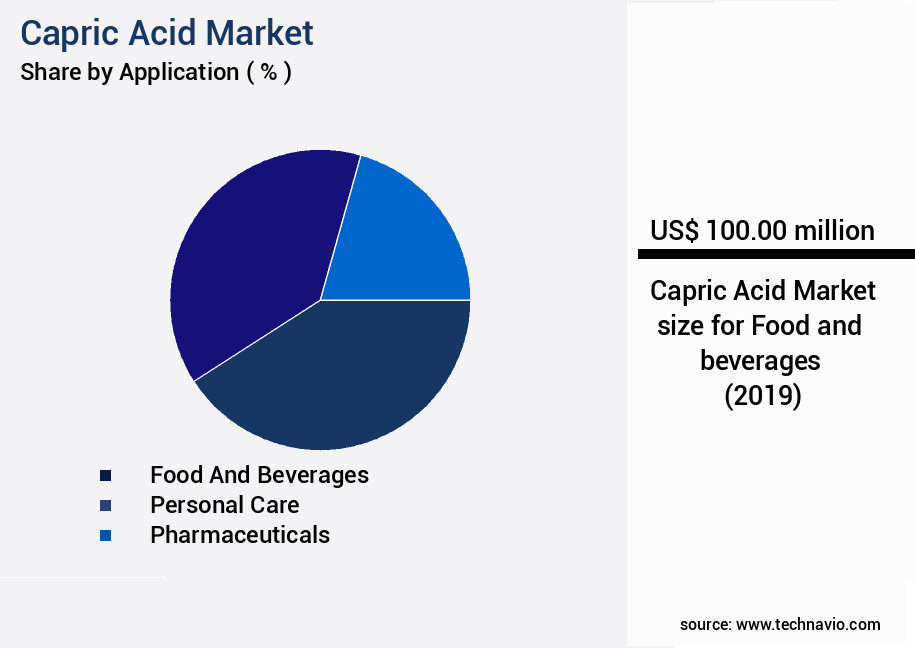
Request Free Sample
The Food and beverages segment was valued at USD 100.00 million in 2019 and showed a gradual increase during the forecast period.
This acid's fungicidal activity and oxidation stability make it an ideal ingredient for various industries. In the detergent manufacturing sector, capric acid acts as an emulsifier and improves the product's overall performance. Moreover, capric acid's antimicrobial and antifungal properties have led to its use in food preservation methods. Its application in the production of medium-chain triglycerides (MCTs) and biodiesel further expands its market potential. The packaging requirements for capric acid depend on its intended use and storage conditions. Thermal stability testing and nuclear magnetic resonance analysis are essential for ensuring product quality and consistency. According to recent studies, the food and beverages segment in the market accounts for approximately 45% of the overall demand.
The market's future growth is expected to be influenced by these factors and emerging trends. For instance, the demand for capric acid in cosmetic ingredients and its use as an antifungal agent is increasing. The market's continuous evolution is driven by these applications and the ongoing research and development efforts in the industry. The market in APAC is expected to grow by 15.2% in the next year, with a further 13.4% growth anticipated over the next five years. Sustainability remains a focus, with emphasis on biodegradability assessment, minimizing environmental impact, and promoting sustainable production. Advanced extraction techniques, fractionation techniques, and spectroscopic methods are used to ensure efficiency, while stringent quality assurance and capric acid quality control parameters maintain product reliability.
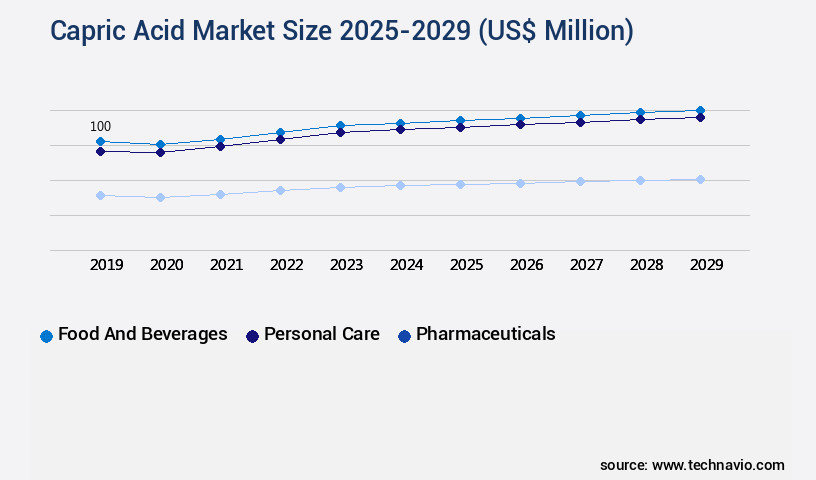
Regional Analysis
APAC is estimated to contribute 40% to the growth of the global market during the forecast period. Technavio's analysts have elaborately explained the regional trends and drivers that shape the market during the forecast period.
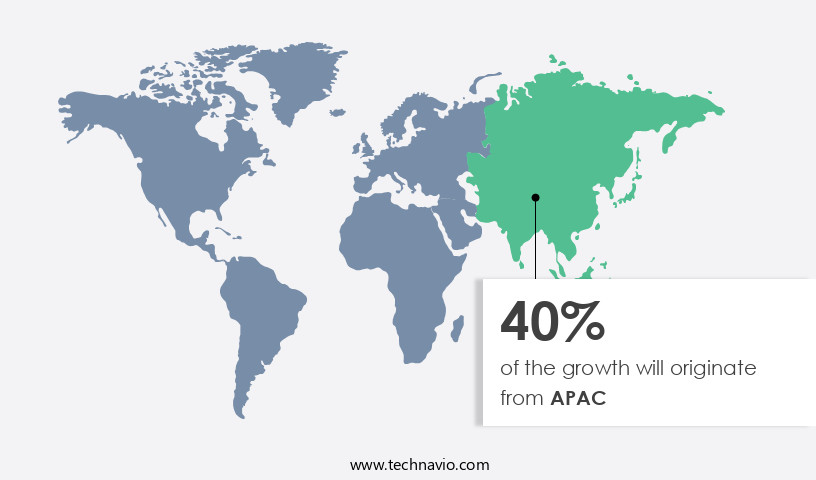
See How capric acid market Demand is Rising in APAC Request Free Sample
The market in Asia Pacific (APAC) is experiencing substantial growth due to the expanding population and increasing focus on health and wellness. This region presents significant opportunities and challenges for capric acid manufacturers and suppliers. The food and dietary supplement and manufacturing industry's growth is a primary driver for the regional market. Countries such as China, India, Indonesia, Thailand, Australia, Japan, the Philippines, Malaysia, and South Korea are anticipated to contribute significantly to the market's revenue growth during the forecast period. Capric acid's health benefits, including weight loss and improved heart health, are gaining consumer awareness in APAC. The hydrolysis process is used to produce capric acid from coconut oil.
Its surfactant properties make it an essential ingredient in various applications, including skincare formulations, detergents, and emulsifiers. Capric acid's fungicidal activity, sensory evaluation, storage conditions, and oxidation stability are crucial factors in its production and application. Infrared spectroscopy, acid value measurement, and chemical composition analysis are essential quality control methods for capric acid. Its antimicrobial properties, toxicity assessment, and solubility in water are critical factors in its use as a food preservative. Capric acid's melting point determination, medium-chain triglyceride production, shelf life testing, and lauric acid synthesis are ongoing processes in the market. The fatty acid profile, biodiesel production, packaging requirements, thermal stability testing, nuclear magnetic resonance analysis, antifungal applications, and mass spectrometry are all integral aspects of the market.
Market Dynamics
Our researchers analyzed the data with 2024 as the base year, along with the key drivers, trends, and challenges. A holistic analysis of drivers will help companies refine their marketing strategies to gain a competitive advantage. The Capric Acid Market is expanding due to its versatile applications across food, cosmetics, pharmaceuticals, polymers, and biofuels. Derived primarily from palm kernel oil processing and capric acid production from coconut oil, this fatty acid is widely used as a cosmetic ingredient in skincare formulation and for emulsifier applications. Industrial demand is also driven by its role in esterification reaction processes, contributing to polymer synthesis and biofuel production.
In pharmaceuticals and personal care, antiviral activity, anti-inflammatory effects, and microbial growth inhibition highlight its bioactive potential. Research explores capric acid antimicrobial efficacy testing, capric acid impact on skin barrier function, and capric acid role in cosmetic product formulation. In food, innovations include capric acid use in food preservation techniques and studying capric acid effects on microbial growth rates. Analytical approaches like capric acid determination using GC-MS analysis support quality validation, while studies on capric acid oxidation stability under different conditions and capric acid solubility in various solvents ensure functionality across industries.
Industrial applications are growing, with capric acid applications in detergent formulation, capric acid use in biodiesel synthesis process, and capric acid use in polymer chemistry applications. Scientific interest continues in capric acid chemical properties and reactivity, capric acid purification by fractional distillation, and capric acid interactions with other fatty acids. Safety and environmental stewardship drive studies on capric acid metabolism in the human body, capric acid environmental fate and transport, and capric acid toxicity studies and safety assessment, ensuring responsible adoption in diverse industries.
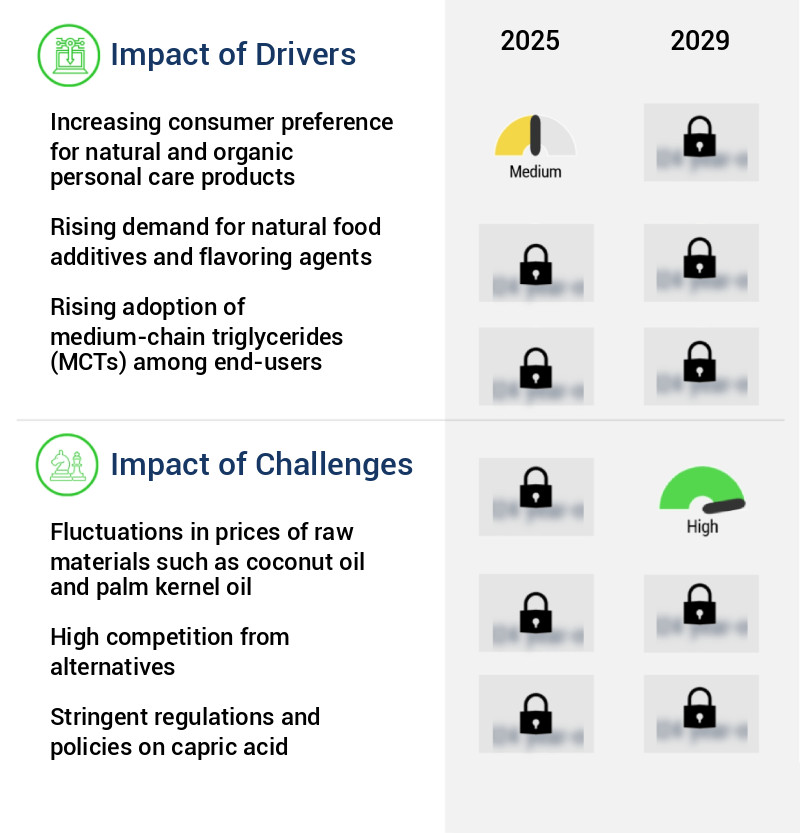
What are the key market drivers leading to the rise in the adoption of Capric Acid Industry?
- The significant shift in consumer preferences towards natural and organic personal care products serves as the primary market driver. The market experiences significant growth due to increasing consumer preference for natural and organic personal care products. This trend is driven by a rising awareness of the benefits of using natural ingredients and avoiding synthetic chemicals.
- The personal care industry's expansion is expected to reach 8% annually, according to market research. Capric acid's versatility and effectiveness in various applications make it an essential ingredient in personal care products. For instance, a leading personal care company reported a 12% increase in sales of skincare products containing capric acid derived from sustainable sources like coconut oil and palm kernel oil.
What are the market trends shaping the Capric Acid Industry?
- Production processes are increasingly being shaped by technological advancements. This trend is set to dominate the market. In the market, technological advancements have significantly influenced production processes, enhancing efficiency, sustainability, and product quality. Notably, the implementation of advanced distillation and purification techniques has led to higher purity levels and improved overall product quality for leading manufacturers. As a result, the market has experienced robust growth, with industry analysts projecting expansion by approximately 12% in the upcoming years.
- A prominent example of market growth can be seen in the food and beverage industry, where capric acid's use as a food additive has rised due to its functional benefits, contributing to a 15% sales increase in this sector. This innovation has enabled them to meet stringent industry standards and cater to diverse end-user requirements in sectors such as food and beverage, pharmaceuticals, and personal care.
What challenges does the Capric Acid Industry face during its growth?
- The volatility in the prices of crude raw materials, such as coconut oil and palm kernel oil, poses a significant challenge to the growth of the industry. For instance, a sudden increase in coconut oil prices can significantly escalate raw material procurement expenses for key players in the market. According to industry reports, the market is projected to grow at a steady pace, with an anticipated expansion of around 5% annually over the next five years.
- The market experiences significant volatility due to the price fluctuations of key raw materials, primarily coconut oil and palm kernel oil. These price changes negatively impact market dynamics, affecting production costs and supply chain management in various industries, including personal care, food and beverages, and industrial applications. The unpredictable pricing of essential raw materials poses challenges for capric acid manufacturers, leading to financial strain and increased costs.
Exclusive Customer Landscape
The capric acid market forecasting report includes the adoption lifecycle of the market, covering from the innovator's stage to the laggard's stage. It focuses on adoption rates in different regions based on penetration. Furthermore, the capric acid market report also includes key purchase criteria and drivers of price sensitivity to help companies evaluate and develop their market growth analysis strategies.
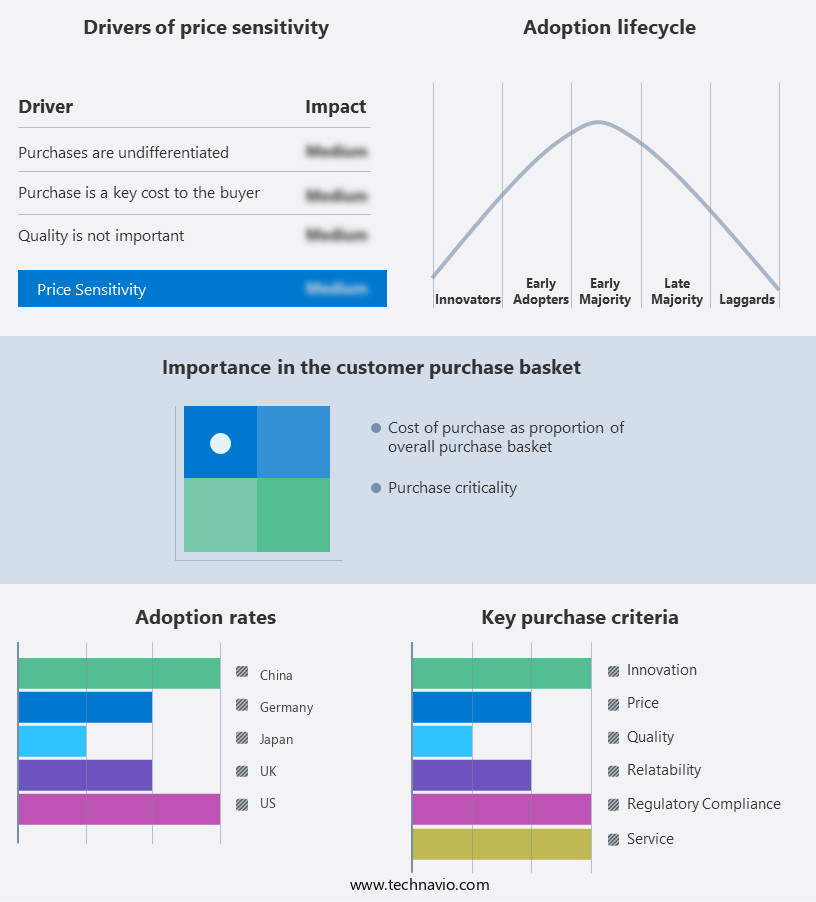
Customer Landscape
Key Companies & Market Insights
Companies are implementing various strategies, such as strategic alliances, capric acid market forecast, partnerships, mergers and acquisitions, geographical expansion, and product/service launches, to enhance their presence in the industry.
Agilent Technologies Inc. - The company specializes in capric acid, providing analytical-grade reagents and derivatives such as decanoic acid for use in chemical laboratories.
The industry research and growth report includes detailed analyses of the competitive landscape of the market and information about key companies, including:
- Agilent Technologies Inc.
- ATAMAN Kimya AS
- AVRIL SCA
- BASF SE
- Berg Schmidt GmbH and Co. KG
- Cargill Inc.
- Croda International Plc
- IOI Corp. BHD
- Kao Corp.
- KLK Oleo
- Loba Chemie Pvt. Ltd.
- Musim Mas Group
- Oleocomm Global SDN BHD
- Otto Chemie Pvt. Ltd.
- PTT Global Chemical Public Co. Ltd.
- The Procter and Gamble Co.
- VVF LLC
- Wilmar International Ltd.
Qualitative and quantitative analysis of companies has been conducted to help clients understand the wider business environment as well as the strengths and weaknesses of key industry players. Data is qualitatively analyzed to categorize companies as pure play, category-focused, industry-focused, and diversified; it is quantitatively analyzed to categorize companies as dominant, leading, strong, tentative, and weak.
Recent Development and News in Capric Acid Market
- In January 2024, Archer Daniels Midland Company (ADM), a leading global food and agricultural enterprise, announced the expansion of its capric acid production capacity at its Decatur, Illinois, facility. This expansion aimed to meet the growing demand for capric acid in various industries, including personal care, food, and pharmaceuticals (ADM press release, 2024).
- In March 2024, Corbion, a global market leader in sustainable biobased ingredients, and DuPont Nutrition & Biosciences, a global biotech company, joined forces to develop a new, sustainable capric and caprylic acid production process. This collaboration aimed to reduce the environmental footprint of capric acid production and improve its availability in the market (Corbion press release, 2024).
- In May 2024, Mitsui Chemicals, a leading Japanese chemical manufacturer, completed the acquisition of a majority stake in Bio-Techne Corporation's biochemicals business. This acquisition included Bio-Techne's capric acid production facility, significantly expanding Mitsui's presence in the market (Mitsui Chemicals press release, 2024).
- In February 2025, the European Commission approved the renewal of the authorization of capric and caprylic acids as food additives. This approval, valid until 2029, confirmed the safety and suitability of these acids for use in various food applications, supporting the market's growth in Europe (European Commission press release, 2025).
Research Analyst Overview
- The market for capric acid, a versatile renewable resource, continues to evolve with advancements in refining processes and purification methods. Capric acid, a medium-chain fatty acid, is widely used in consumer products due to its enzyme activity and nutritional value. In the realm of industry, it plays a significant role in the production of sustainable biofuels and the synthesis of polymers. One notable example of capric acid's market impact is its application in the refining industry. Capric acid's chemical reactivity and chain length distribution make it an essential component in the production of biodiesel, which has seen a growth expectation of approximately 15% annually.
- Additionally, capric acid's antimicrobial properties contribute to its use in various industries, including pharmaceuticals and food processing, where it inhibits microbial growth and enhances product quality. Capric acid's integration into various applications is driven by its functional groups and metabolic effects. It is used in derivatization reactions, lipid metabolism, and chromatographic separation techniques. Furthermore, its saturation degree and cell membrane interaction contribute to its potential use in drug delivery systems and wound healing. The continuous research and development in capric acid's applications underscore its importance as a valuable resource in the evolving market landscape.
Dive into Technavio's robust research methodology, blending expert interviews, extensive data synthesis, and validated models for unparalleled Capric Acid Market insights. See full methodology.
|
Market Scope
|
|
Report Coverage
|
Details
|
|
Page number
|
226
|
|
Base year
|
2024
|
|
Historic period
|
2019-2023 |
|
Forecast period
|
2025-2029
|
|
Growth momentum & CAGR
|
Accelerate at a CAGR of 7.6%
|
|
Market growth 2025-2029
|
USD 149.9 million
|
|
Market structure
|
Fragmented
|
|
YoY growth 2024-2025(%)
|
7.0
|
|
Key countries
|
US, China, Japan, India, UK, Canada, Germany, South Korea, France, and Australia
|
|
Competitive landscape
|
Leading Companies, Market Positioning of Companies, Competitive Strategies, and Industry Risks
|
Request Free Sample
What are the Key Data Covered in this Capric Acid Market Research and Growth Report?
- CAGR of the Capric Acid industry during the forecast period
- Detailed information on factors that will drive the growth and forecasting between 2025 and 2029
- Precise estimation of the size of the market and its contribution of the industry in focus to the parent market
- Accurate predictions about upcoming growth and trends and changes in consumer behaviour
- Growth of the market across APAC, North America, Europe, South America, and Middle East and Africa
- Thorough analysis of the market's competitive landscape and detailed information about companies
- Comprehensive analysis of factors that will challenge the capric acid market growth of industry companies
We can help! Our analysts can customize this capric acid market research report to meet your requirements.
Get in touch
1 Executive Summary
- 1.1 Market overview
- Executive Summary - Chart on Market Overview
- Executive Summary - Data Table on Market Overview
- Executive Summary - Chart on Global Market Characteristics
- Executive Summary - Chart on Market by Geography
- Executive Summary - Chart on Market Segmentation by Application
- Executive Summary - Chart on Market Segmentation by Source
- Executive Summary - Chart on Market Segmentation by Grade Type
- Executive Summary - Chart on Incremental Growth
- Executive Summary - Data Table on Incremental Growth
- Executive Summary - Chart on Company Market Positioning
2 Technavio Analysis
- 2.1 Analysis of price sensitivity, lifecycle, customer purchase basket, adoption rates, and purchase criteria
- Analysis of price sensitivity, lifecycle, customer purchase basket, adoption rates, and purchase criteria
- 2.2 Criticality of inputs and Factors of differentiation
- Overview on criticality of inputs and factors of differentiation
- 2.3 Factors of disruption
- Overview on factors of disruption
- 2.4 Impact of drivers and challenges
- Impact of drivers and challenges in 2024 and 2029
3 Market Landscape
- 3.1 Market ecosystem
- Parent Market
- Data Table on - Parent Market
- 3.2 Market characteristics
- Market characteristics analysis
4 Market Sizing
- 4.1 Market definition
- Offerings of companies included in the market definition
- 4.2 Market segment analysis
- 4.4 Market outlook: Forecast for 2024-2029
- Chart on Global - Market size and forecast 2024-2029 ($ million)
- Data Table on Global - Market size and forecast 2024-2029 ($ million)
- Chart on Global Market: Year-over-year growth 2024-2029 (%)
- Data Table on Global Market: Year-over-year growth 2024-2029 (%)
5 Historic Market Size
- 5.1 Global Capric Acid Market 2019 - 2023
- Historic Market Size - Data Table on Global Capric Acid Market 2019 - 2023 ($ million)
- 5.2 Application segment analysis 2019 - 2023
- Historic Market Size - Application Segment 2019 - 2023 ($ million)
- 5.3 Source segment analysis 2019 - 2023
- Historic Market Size - Source Segment 2019 - 2023 ($ million)
- 5.4 Grade Type segment analysis 2019 - 2023
- Historic Market Size - Grade Type Segment 2019 - 2023 ($ million)
- 5.5 Geography segment analysis 2019 - 2023
- Historic Market Size - Geography Segment 2019 - 2023 ($ million)
- 5.6 Country segment analysis 2019 - 2023
- Historic Market Size - Country Segment 2019 - 2023 ($ million)
6 Qualitative Analysis
- 6.1 The AI impact on Global Capric Acid Market
7 Five Forces Analysis
- 7.1 Five forces summary
- Five forces analysis - Comparison between 2024 and 2029
- 7.2 Bargaining power of buyers
- Bargaining power of buyers - Impact of key factors 2024 and 2029
- 7.3 Bargaining power of suppliers
- Bargaining power of suppliers - Impact of key factors in 2024 and 2029
- 7.4 Threat of new entrants
- Threat of new entrants - Impact of key factors in 2024 and 2029
- 7.5 Threat of substitutes
- Threat of substitutes - Impact of key factors in 2024 and 2029
- 7.6 Threat of rivalry
- Threat of rivalry - Impact of key factors in 2024 and 2029
- 7.7 Market condition
- Chart on Market condition - Five forces 2024 and 2029
8 Market Segmentation by Application
- 8.1 Market segments
- Chart on Application - Market share 2024-2029 (%)
- Data Table on Application - Market share 2024-2029 (%)
- 8.2 Comparison by Application
- Chart on Comparison by Application
- Data Table on Comparison by Application
- 8.3 Food and beverages - Market size and forecast 2024-2029
- Chart on Food and beverages - Market size and forecast 2024-2029 ($ million)
- Data Table on Food and beverages - Market size and forecast 2024-2029 ($ million)
- Chart on Food and beverages - Year-over-year growth 2024-2029 (%)
- Data Table on Food and beverages - Year-over-year growth 2024-2029 (%)
- 8.4 Personal care - Market size and forecast 2024-2029
- Chart on Personal care - Market size and forecast 2024-2029 ($ million)
- Data Table on Personal care - Market size and forecast 2024-2029 ($ million)
- Chart on Personal care - Year-over-year growth 2024-2029 (%)
- Data Table on Personal care - Year-over-year growth 2024-2029 (%)
- 8.5 Pharmaceuticals - Market size and forecast 2024-2029
- Chart on Pharmaceuticals - Market size and forecast 2024-2029 ($ million)
- Data Table on Pharmaceuticals - Market size and forecast 2024-2029 ($ million)
- Chart on Pharmaceuticals - Year-over-year growth 2024-2029 (%)
- Data Table on Pharmaceuticals - Year-over-year growth 2024-2029 (%)
- 8.6 Others - Market size and forecast 2024-2029
- Chart on Others - Market size and forecast 2024-2029 ($ million)
- Data Table on Others - Market size and forecast 2024-2029 ($ million)
- Chart on Others - Year-over-year growth 2024-2029 (%)
- Data Table on Others - Year-over-year growth 2024-2029 (%)
- 8.7 Market opportunity by Application
- Market opportunity by Application ($ million)
- Data Table on Market opportunity by Application ($ million)
9 Market Segmentation by Source
- 9.1 Market segments
- Chart on Source - Market share 2024-2029 (%)
- Data Table on Source - Market share 2024-2029 (%)
- 9.2 Comparison by Source
- Chart on Comparison by Source
- Data Table on Comparison by Source
- 9.3 Plant - Market size and forecast 2024-2029
- Chart on Plant - Market size and forecast 2024-2029 ($ million)
- Data Table on Plant - Market size and forecast 2024-2029 ($ million)
- Chart on Plant - Year-over-year growth 2024-2029 (%)
- Data Table on Plant - Year-over-year growth 2024-2029 (%)
- 9.4 Animal - Market size and forecast 2024-2029
- Chart on Animal - Market size and forecast 2024-2029 ($ million)
- Data Table on Animal - Market size and forecast 2024-2029 ($ million)
- Chart on Animal - Year-over-year growth 2024-2029 (%)
- Data Table on Animal - Year-over-year growth 2024-2029 (%)
- 9.5 Market opportunity by Source
- Market opportunity by Source ($ million)
- Data Table on Market opportunity by Source ($ million)
10 Market Segmentation by Grade Type
- 10.1 Market segments
- Chart on Grade Type - Market share 2024-2029 (%)
- Data Table on Grade Type - Market share 2024-2029 (%)
- 10.2 Comparison by Grade Type
- Chart on Comparison by Grade Type
- Data Table on Comparison by Grade Type
- 10.3 Food grade - Market size and forecast 2024-2029
- Chart on Food grade - Market size and forecast 2024-2029 ($ million)
- Data Table on Food grade - Market size and forecast 2024-2029 ($ million)
- Chart on Food grade - Year-over-year growth 2024-2029 (%)
- Data Table on Food grade - Year-over-year growth 2024-2029 (%)
- 10.4 Industrial grade - Market size and forecast 2024-2029
- Chart on Industrial grade - Market size and forecast 2024-2029 ($ million)
- Data Table on Industrial grade - Market size and forecast 2024-2029 ($ million)
- Chart on Industrial grade - Year-over-year growth 2024-2029 (%)
- Data Table on Industrial grade - Year-over-year growth 2024-2029 (%)
- 10.5 Cosmetic grade - Market size and forecast 2024-2029
- Chart on Cosmetic grade - Market size and forecast 2024-2029 ($ million)
- Data Table on Cosmetic grade - Market size and forecast 2024-2029 ($ million)
- Chart on Cosmetic grade - Year-over-year growth 2024-2029 (%)
- Data Table on Cosmetic grade - Year-over-year growth 2024-2029 (%)
- 10.6 Market opportunity by Grade Type
- Market opportunity by Grade Type ($ million)
- Data Table on Market opportunity by Grade Type ($ million)
11 Customer Landscape
- 11.1 Customer landscape overview
- Analysis of price sensitivity, lifecycle, customer purchase basket, adoption rates, and purchase criteria
12 Geographic Landscape
- 12.1 Geographic segmentation
- Chart on Market share by geography 2024-2029 (%)
- Data Table on Market share by geography 2024-2029 (%)
- 12.2 Geographic comparison
- Chart on Geographic comparison
- Data Table on Geographic comparison
- 12.3 APAC - Market size and forecast 2024-2029
- Chart on APAC - Market size and forecast 2024-2029 ($ million)
- Data Table on APAC - Market size and forecast 2024-2029 ($ million)
- Chart on APAC - Year-over-year growth 2024-2029 (%)
- Data Table on APAC - Year-over-year growth 2024-2029 (%)
- 12.4 North America - Market size and forecast 2024-2029
- Chart on North America - Market size and forecast 2024-2029 ($ million)
- Data Table on North America - Market size and forecast 2024-2029 ($ million)
- Chart on North America - Year-over-year growth 2024-2029 (%)
- Data Table on North America - Year-over-year growth 2024-2029 (%)
- 12.5 Europe - Market size and forecast 2024-2029
- Chart on Europe - Market size and forecast 2024-2029 ($ million)
- Data Table on Europe - Market size and forecast 2024-2029 ($ million)
- Chart on Europe - Year-over-year growth 2024-2029 (%)
- Data Table on Europe - Year-over-year growth 2024-2029 (%)
- 12.6 South America - Market size and forecast 2024-2029
- Chart on South America - Market size and forecast 2024-2029 ($ million)
- Data Table on South America - Market size and forecast 2024-2029 ($ million)
- Chart on South America - Year-over-year growth 2024-2029 (%)
- Data Table on South America - Year-over-year growth 2024-2029 (%)
- 12.7 Middle East and Africa - Market size and forecast 2024-2029
- Chart on Middle East and Africa - Market size and forecast 2024-2029 ($ million)
- Data Table on Middle East and Africa - Market size and forecast 2024-2029 ($ million)
- Chart on Middle East and Africa - Year-over-year growth 2024-2029 (%)
- Data Table on Middle East and Africa - Year-over-year growth 2024-2029 (%)
- 12.8 US - Market size and forecast 2024-2029
- Chart on US - Market size and forecast 2024-2029 ($ million)
- Data Table on US - Market size and forecast 2024-2029 ($ million)
- Chart on US - Year-over-year growth 2024-2029 (%)
- Data Table on US - Year-over-year growth 2024-2029 (%)
- 12.9 China - Market size and forecast 2024-2029
- Chart on China - Market size and forecast 2024-2029 ($ million)
- Data Table on China - Market size and forecast 2024-2029 ($ million)
- Chart on China - Year-over-year growth 2024-2029 (%)
- Data Table on China - Year-over-year growth 2024-2029 (%)
- 12.10 Japan - Market size and forecast 2024-2029
- Chart on Japan - Market size and forecast 2024-2029 ($ million)
- Data Table on Japan - Market size and forecast 2024-2029 ($ million)
- Chart on Japan - Year-over-year growth 2024-2029 (%)
- Data Table on Japan - Year-over-year growth 2024-2029 (%)
- 12.11 UK - Market size and forecast 2024-2029
- Chart on UK - Market size and forecast 2024-2029 ($ million)
- Data Table on UK - Market size and forecast 2024-2029 ($ million)
- Chart on UK - Year-over-year growth 2024-2029 (%)
- Data Table on UK - Year-over-year growth 2024-2029 (%)
- 12.12 India - Market size and forecast 2024-2029
- Chart on India - Market size and forecast 2024-2029 ($ million)
- Data Table on India - Market size and forecast 2024-2029 ($ million)
- Chart on India - Year-over-year growth 2024-2029 (%)
- Data Table on India - Year-over-year growth 2024-2029 (%)
- 12.13 Canada - Market size and forecast 2024-2029
- Chart on Canada - Market size and forecast 2024-2029 ($ million)
- Data Table on Canada - Market size and forecast 2024-2029 ($ million)
- Chart on Canada - Year-over-year growth 2024-2029 (%)
- Data Table on Canada - Year-over-year growth 2024-2029 (%)
- 12.14 Germany - Market size and forecast 2024-2029
- Chart on Germany - Market size and forecast 2024-2029 ($ million)
- Data Table on Germany - Market size and forecast 2024-2029 ($ million)
- Chart on Germany - Year-over-year growth 2024-2029 (%)
- Data Table on Germany - Year-over-year growth 2024-2029 (%)
- 12.15 South Korea - Market size and forecast 2024-2029
- Chart on South Korea - Market size and forecast 2024-2029 ($ million)
- Data Table on South Korea - Market size and forecast 2024-2029 ($ million)
- Chart on South Korea - Year-over-year growth 2024-2029 (%)
- Data Table on South Korea - Year-over-year growth 2024-2029 (%)
- 12.16 France - Market size and forecast 2024-2029
- Chart on France - Market size and forecast 2024-2029 ($ million)
- Data Table on France - Market size and forecast 2024-2029 ($ million)
- Chart on France - Year-over-year growth 2024-2029 (%)
- Data Table on France - Year-over-year growth 2024-2029 (%)
- 12.17 Australia - Market size and forecast 2024-2029
- Chart on Australia - Market size and forecast 2024-2029 ($ million)
- Data Table on Australia - Market size and forecast 2024-2029 ($ million)
- Chart on Australia - Year-over-year growth 2024-2029 (%)
- Data Table on Australia - Year-over-year growth 2024-2029 (%)
- 12.18 Market opportunity by geography
- Market opportunity by geography ($ million)
- Data Tables on Market opportunity by geography ($ million)
13 Drivers, Challenges, and Opportunity/Restraints
- 13.3 Impact of drivers and challenges
- Impact of drivers and challenges in 2024 and 2029
- 13.4 Market opportunities/restraints
14 Competitive Landscape
- 14.2 Competitive Landscape
- Overview on criticality of inputs and factors of differentiation
- 14.3 Landscape disruption
- Overview on factors of disruption
- 14.4 Industry risks
- Impact of key risks on business
15 Competitive Analysis
- 15.2 Company ranking index
- 15.3 Market positioning of companies
- Matrix on companies position and classification
- 15.4 Agilent Technologies Inc.
- Agilent Technologies Inc. - Overview
- Agilent Technologies Inc. - Business segments
- Agilent Technologies Inc. - Key news
- Agilent Technologies Inc. - Key offerings
- Agilent Technologies Inc. - Segment focus
- SWOT
- 15.5 ATAMAN Kimya AS
- ATAMAN Kimya AS - Overview
- ATAMAN Kimya AS - Product / Service
- ATAMAN Kimya AS - Key offerings
- SWOT
- 15.6 AVRIL SCA
- AVRIL SCA - Overview
- AVRIL SCA - Product / Service
- AVRIL SCA - Key offerings
- SWOT
- 15.7 BASF SE
- BASF SE - Overview
- BASF SE - Business segments
- BASF SE - Key news
- BASF SE - Key offerings
- BASF SE - Segment focus
- SWOT
- 15.8 Berg Schmidt GmbH and Co. KG
- Berg Schmidt GmbH and Co. KG - Overview
- Berg Schmidt GmbH and Co. KG - Product / Service
- Berg Schmidt GmbH and Co. KG - Key offerings
- SWOT
- 15.9 Croda International Plc
- Croda International Plc - Overview
- Croda International Plc - Business segments
- Croda International Plc - Key offerings
- Croda International Plc - Segment focus
- SWOT
- 15.10 IOI Corp. BHD
- IOI Corp. BHD - Overview
- IOI Corp. BHD - Business segments
- IOI Corp. BHD - Key offerings
- IOI Corp. BHD - Segment focus
- SWOT
- 15.11 Kao Corp.
- Kao Corp. - Overview
- Kao Corp. - Business segments
- Kao Corp. - Key news
- Kao Corp. - Key offerings
- Kao Corp. - Segment focus
- SWOT
- 15.12 KLK Oleo
- KLK Oleo - Overview
- KLK Oleo - Product / Service
- KLK Oleo - Key offerings
- SWOT
- 15.13 Musim Mas Group
- Musim Mas Group - Overview
- Musim Mas Group - Product / Service
- Musim Mas Group - Key offerings
- SWOT
- 15.14 Oleocomm Global SDN BHD
- Oleocomm Global SDN BHD - Overview
- Oleocomm Global SDN BHD - Product / Service
- Oleocomm Global SDN BHD - Key offerings
- SWOT
- 15.15 PTT Global Chemical Public Co. Ltd.
- PTT Global Chemical Public Co. Ltd. - Overview
- PTT Global Chemical Public Co. Ltd. - Business segments
- PTT Global Chemical Public Co. Ltd. - Key offerings
- PTT Global Chemical Public Co. Ltd. - Segment focus
- SWOT
- 15.16 The Procter and Gamble Co.
- The Procter and Gamble Co. - Overview
- The Procter and Gamble Co. - Business segments
- The Procter and Gamble Co. - Key offerings
- The Procter and Gamble Co. - Segment focus
- SWOT
- 15.17 VVF LLC
- VVF LLC - Overview
- VVF LLC - Product / Service
- VVF LLC - Key offerings
- SWOT
- 15.18 Wilmar International Ltd.
- Wilmar International Ltd. - Overview
- Wilmar International Ltd. - Business segments
- Wilmar International Ltd. - Key offerings
- Wilmar International Ltd. - Segment focus
- SWOT
16 Appendix
- 16.2 Inclusions and exclusions checklist
- Inclusions checklist
- Exclusions checklist
- 16.3 Currency conversion rates for US$
- Currency conversion rates for US$
- 16.4 Research methodology
- 16.7 Validation techniques employed for market sizing
- Validation techniques employed for market sizing
- 16.9 360 degree market analysis
- 360 degree market analysis
- 16.10 List of abbreviations







![]() Get the report (PDF) sent to your email within minutes.
Get the report (PDF) sent to your email within minutes.
Complimentary full Excel data with your report purchase.